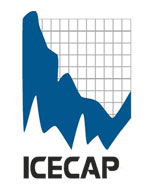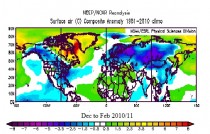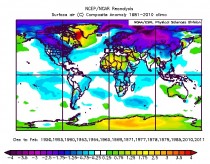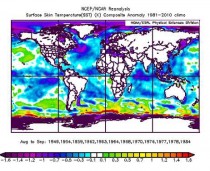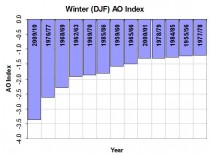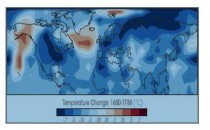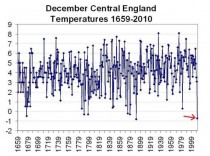By Joseph D’Aleo, CCM, weatherbell.com
A new study led by the Georgia Institute of Technology attempted to support a relationship reported in recent years (Overland) between melting ice in the Arctic regions and widespread cold outbreaks in the Northern Hemisphere. “We think the recent snowy winters could be caused by the retreating Arctic ice altering atmospheric circulation patterns by weakening westerly winds, increasing the amplitude of the jet stream and increasing the amount of moisture in the atmosphere,” explained Jiping Liu, a senior research scientist in the School of Earth and Atmospheric Sciences at Georgia Tech. “These pattern changes enhance blocking patterns that favor more frequent movement of cold air masses to middle and lower latitudes, leading to increased heavy snowfall in Europe and the Northeast and Midwest regions of the United States.”
They used the two extreme winters of 2009/10 and 2010/11 across the Northern Hemisphere as evidence to support this relationship. Extreme northern hemisphere winters with frigid cold and deep snows do occur, often in clusters and historically we will show have related to changing large scale circulation patterns. They dominated in the Mini and Little Ice Ages.
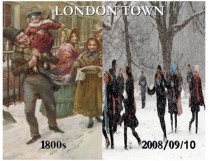
Enlarged.
Since they have occurred in the past, one has to look at natural factors and natural circulations.
Both winters were characterized by a strong negative North Atlantic and Arctic Oscillations. These ‘wildcards’ are well known by forecasters to override or amplify the patterns associated with factors like ENSO.
Indeed the winter of 2009/10 was a moderately strong El Nino and the winter of 2010/11 a very strong La Nina (by some measures the second strongest in the last century). Yet the patterns associated with the two winters was nearly identical. And very much in line with a negative NAO/AO.
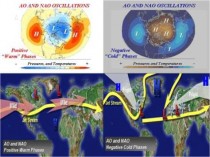
Enlarged.
In the positive stage of the AO and NAO as we saw this November, December and first part of January, a tight polar vortex leads to westerly winds into North America from the Pacific and from the Atlantic into Europe. Mild conditions prevail as they did (and continue in the US) this year.
The negative NAO/AO on the other hand leads to polar high pressure forcing cold air to mid latitudes. In North America the cold air is forced south.
In Europe, the high latitude “blocking” high pressure allows frigid Siberian air west. Indeed both North America and Europe were hard hit with cold from the blocking in 2009/10 and 2010/11 despite the strong El Nino in one year and La Nina in the second.
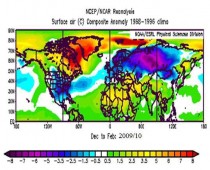
Enlarged.
The two winters across the hemisphere ranked #2 (2009/10) and #3 among the winters of greatest winter snow extent behind only the legendary 1977/78 and just ahead of 2007/08 and 2002/03. Thus 4 of the top 5 snowiest years on record have occurred in the last decade.
Even with the lack of snow in the lower 48 states this year, hemispheric snowcover is ABOVE normal again.
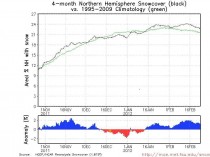
Enlarged.
Until the scurrying around to find an excuse for the cold and snow when the forecast was for decreasing cold and snow in middle latitudes as late as 2007, they settled on diminished arctic ice forcing a negative AO/NAO. This was despite the fact that the climate models predicted with warming, an increased AO.
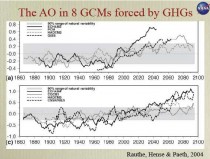
Enlarged.
SUMMER ARCTIC TEMPERTURES, BLOCKING AND COLD WINTERS
As for the idea that CO2 through arctic ice reduction and a warm arctic was responsible for the blocking, we looked at the standardized NAO winter values for winters since 1950. (CPC)
Winter NAO
2010 -2.12
1963 -1.94
1964 -1.85
1969 -1.69
1979 -1.62
1977 -1.43
1960 -1.43
1955 -1.27
1978 -1.23
1985 -1.16
1966 -1.13
1971 -1.06
1965 -1.03
2011 -0.99
December to February NAO (STD)
You can see from the composite of these very blocky years, the pattern is virtually identical to that of 2009/10, 2010/11 in December to February. To show an ‘independent’ data set, I eliminated 2009/10 and 2010/11 in the second chart - with little change in the results.
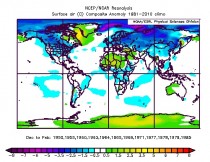
Enlarged.
What about arctic water temperatures in August and September of those years. Was the arctic warm in those identical years leading to the blocky following winters? NO! Not according to NCEP reanalysis. It was cold in the late summer and early fall throughout the arctic.
NATURAL CAUSES
There are few natural causes discussed in the peer review literature relating to high latitude blocking. The two that appeared to play a role the last two cold winters were the high latitude volcanoes and very low solar activity.
HIGH LATITUDE VOLCANOES
Climatologists may disagree on how much the recent global warming is natural or manmade but there is general agreement that volcanism constitutes a wildcard in climate, producing significant global scale cooling for at least a few years following a major eruption. However, there are some interesting seasonal and regional variations of the effects.
Oman and Robock (2005) and others have shown that though major volcanic eruptions seem to have their greatest cooling effect in the summer months, the location of the volcano determines whether the winters are colder or warmer over large parts of North America and Eurasia. According to their modeling, tropical region volcanoes like El Chichon and Pinatubo actually produce a warming in winter due to a tendency for a more positive North Atlantic Oscillation (NAO) and Arctic Oscillation (AO).
They found high latitude volcanoes like Katmai (Alaska in 1912) instead favored the negative phase of the Arctic and North Atlantic Oscillations and cold winters. In the negative phase, the jet stream winds buckled and forced cold air south from Canada into the eastern United States and west from Siberia into Europe. They also favored a cooling of middle and higher latitudes the year round of that atmosphere and a weakening of the summer monsoon in India.
Several high latitude volcanoes have erupted in recent years- Kasatochi in Alaska in 2008, Mt. Redoubt in Alaska and Sarychev in Russia in 2009 and Eyjafjallajökull in Iceland in 2010 and Grimsvotn in 2011.
In addition to the strong blocking observed in 2009/10 and early in 2010/11, the Indian monsoon season was erratic in 2009 and again in 2011.
SOLAR CYCLES
Also important to the NAO/AO is low solar activity. Though solar irradiance varies slightly over the 11 year cycle, radiation at longer UV wavelengths are known to increase by several (6-8% or more) percent with still larger changes (factor of two or more) at extremely short UV and X-ray wavelengths (Baldwin and Dunkerton, JAS 2004).
Energetic flares increase the UV radiation by 16%. Ozone in the stratosphere absorbs this excess energy and this heat has been shown to propagate downward and affect the general circulation in the troposphere. Shindell (1999) used a climate model that included ozone chemistry to reproduce this warming during high flux (high UV) years. Labitzke and Van Loon (1988) and later Labitzke in numerous papers has shown that high flux (which correlates very well with UV) produces a warming in low and middle latitudes in winter in the stratosphere with subsequent dynamical and radiative coupling to the troposphere. The researchers show that at solar minimum, a weakened polar circulation (negative AO/NAO) was more likely when the Quasi Biennial Oscillation was easterly (as in 2009/10).
Shindell used this ozone chemistry based modeling to demonstrate how the lack of UV might have contributed to the cold of the Maunder Minimum. Their model showed when the sun was quiet in 1680, it was much colder than when it became active again one hundred years later (see figure below). “During this period, very few sunspots appeared on the surface of the Sun, and the overall brightness of the Sun decreased slightly. Already in the midst of a colder-than-average period called the Little Ice Age, Europe and North America went into a deep freeze: alpine glaciers extended over valley farmland; sea ice crept south from the Arctic; and the famous canals in the Netherlands froze regularly - an event that is rare today.” (
Writing in Environmental Research Letters (2010), Mike Lockwood et al. have verified that solar activity does seem to have a direct correlation with Earth’s climate by influencing North Atlantic blocking (NAO) as Shindell has shown. The reason that the scope of the study is limited to that area, or at most Europe, is that it is one of the few regions that there is a reliable, continuous temperature record going back to the Little Ice Age.
They noted further “solar activity during the current sunspot minimum has fallen to levels unknown since the start of the 20th century. The Maunder minimum (about 1650–1700) was a prolonged episode of low solar activity which coincided with more severe winters in the United Kingdom and continental Europe. Motivated by recent relatively cold winters in the UK, we investigate the possible connection with solar activity. We identify regionally anomalous cold winters by detrending the Central England temperature (CET) record using reconstructions of the northern hemisphere mean temperature.
We show that cold winter excursions from the hemispheric trend occur more commonly in the UK during low solar activity, consistent with the solar influence on the occurrence of persistent blocking events in the eastern Atlantic. We stress that this is a regional and seasonal effect relating to European winters and not a global effect. Average solar activity has declined rapidly since 1985 and cosmogenic isotopes suggest an 8% chance of a return to Maunder minimum conditions within the next 50 years (Lockwood 2010 Proc. R. Soc. A 466 303–29): the results presented here indicate that, despite hemispheric warming, the UK and Europe could experience more cold winters than during recent decades.”
The last extended solar minimum was the deepest and longest in over a century.
The 2009/10 winter with a record negative arctic oscillation and persistent negative NAO was the coldest in the UK and the southeastern United States since 1977/78, coldest in Scotland since 1962/63, coldest ever recorded in parts of Siberia. Coldest weather since 1971/72 was reported in parts of North China. December 2010 was the second coldest December in the CET since 1659 in the Little Ice Age.
The decadal changes in the United States are impressive. These numbers will drop after this top 10 warmest rebound winter for the lower 48 states.
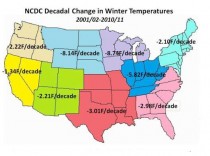
Enlarged.
It seems a steady stream of the tenets of the WG movement has been failing in recent years - 15 years of non warming, slowing and even falling sea levels, no increases in the ocean heat content, colder winters and increasing hemispheric snows, the missing hot spot in the tropics mid troposphere, a troposphere warming much slower than the surface when models suggest the opposite, increasing (7 out last 10) ENSO events being La Nina when we were promised a permanent El Nino, record high polar bear populations, recovering Kilimanjaro ice and no Himalayan ice loss, and on and on (I created a listy of 30 without even trying hard). In every case, papers that attempt to make these changes ‘consistent’ with global warming are rushed through peer (‘pal’) review and the all too compliant media are quick to promote them to save the ‘cause’.
When they lose these turning points they turn to trying to hype the never ending stream of extreme weather as evidence of climate disruption. The extremes cluster for the same natural reasons (last year’s extremes can be blamed on the second strongest La Nina in the last century in 2010/11). Many of us who have spent decades looking at data and natural causes for these weather changes or regimes and virtually always can find them. The only constant in nature is that weather and climate will change.
Having taught a course at Georgia Tech and worked on my doctorate there while Director of Meteorology at The Weather Channel, I have an attachment for Georgia Tech’s program and have enormous respect for Judith Curry who maintains an open mind and wonderfully balanced blog on climate.
REFERENCES:
Baldwin, M.P., Dunkerton, T.J.: (2004) The solar cycle and stratospheric-tropsospheric dynamical coupling, JAS 2004
Labitzke, K., The global signal of the 11-year sunspot cycle in the stratosphere: Differences between solar maxima and minima, Meteorol. Zeitschift, 10, 83-90, 2001.
Lockwood, M., Harrison, R.G., Woollings T., and Solanki, S.K., (2010) Are cold winters in Europe associated with low solar activity? Environ. Res. Lett. 5 (April-June 2010) 024001
Oman, L., A. Robock, G. Stenchikov, G. A. Schmidt, and R. Ruedy (2005), Climatic response to high-latitude volcanic eruptions, J. Geophys. Res., 110,
Overland, J. E., and M. Wang, 2010: Large-scale atmospheric circulation changes associated with the recent loss of Arctic sea ice. Tellus, 62A, 1.9.
Rauthe, M., Hense, A. and Paeth, H. (2004), A model intercomparison study of climate change-signals in extratropical circulation. International Journal of Climatology, 24: 643-662
Shindell, D.T., D. Rind, N. Balachandran, J. Lean, and P. Lonergan, Solar cycle variability, ozone, and climate, Science, 284, 305–308, 1999a.
A lecture by Christopher Monckton of Brenchley
No need for guilt about your sins of emission.
The science is in, the truth is out, Al Gore is through, the game is up, and the scare is over.
There has been no global warming for 15 years. Warming since 1990 has been below the IPCC’s least estimate. For 8 years, sea level has risen at a rate equivalent to 1 inch per century. Pacific atolls are not drowning. Hurricanes are as quiet as they have been in 30 years. Global sea-ice extent has hardly changed. Polar bears thrive. The snows of Kilimanjaro are growing. The 50 million climate refugees the UN had predicted by 2010 do not exist. The news media reported the fears but have not reported the facts. Systemic errors in determining how much global warming Man will cause, with fraudulent manipulation of data and results, whipped up predictions of catastrophe. Those predictions are now proven baseless. Government projections as greatly overstate the costs of climate action as they understate the welfare losses from inaction. The cost of mitigating global warming this century exceeds tenfold the welfare loss from the climate-related damage expected if we do not act. Mitigation policies inexpensive enough to be affordable will be ineffective: policies costly enough to be effective will be unaffordable. It is unlikely that any CO2-mitigation policy will prove cost-effective solely on grounds of the welfare benefit foreseeable from mitigation alone. Focused adaptation to any adverse consequences of future global warming is likely to prove more cost-effective than attempted mitigation, which is one of the least efficient uses of taxpayers’ money in history.
Attempts by the international classe politique to fabricate climate fears as a Trojan Horse to end democracy and establish an all-powerful, unelected world government continue. The menace that climate extremism poses to the prosperity, liberty, and democracy of the West persists, but all rational scientific and economic basis for extreme alarm has gone. The science is in, the truth is out, Al Gore is through, the game is up, and the scare is over. Will someone tell the President?
Christopher, Viscount Monckton of Brenchley is a retired British international business consultant, policy advisor, writer, and inventor. He served as policy advisor to Margaret Thatcher, former Prime Minister of the United Kingdom. Viscount Monckton has gained international attention through his extensively reasoned critiques of “global warming” and the apparently widespread belief that the science is settled. He has also examined related policy decisions with
regard to their costs to the economy and to a free society.
The climate of freedom
Friday, March 2, 2012 2:30 P.M.
United Technologies Hall
Room 320
University of Hartford
The event is Free & Open to the Public
Parking is in A Lot or B Lot
http://www.hartford.edu/march2012/aeparking.pdf
Steven F. Hayward, March 5, 2012, Vol. 17, No. 24
The forlorn and increasingly desperate climate campaign achieved a new level of ineptitude last week when what had looked like a minor embarrassment for one of its critics - the Chicago-based Heartland Institute - turned out to be a full-fledged catastrophe for itself. A moment’s reflection on the root of this episode points to why the climate campaign is out of (greenhouse) gas.
In an obvious attempt to inflict a symmetrical Climategate-style scandal on the skeptic community, someone representing himself as a Heartland Institute insider “leaked” internal documents for Heartland’s most recent board of directors meeting to a fringe environmental blog, along with a photocopy of a supposed Heartland “strategy memo” outlining a plan to disseminate a public school curriculum aimed at “dissuading teachers from teaching science.”
This ham-handed phrase (one of many) should have been a tipoff to treat the document dump with some skepticism (a trait that has gone missing from much of the climate science community). But more than a few environmental blogs and mainstream news outlets ran with the story of how this “leak” exposed the nefarious “antiscience” Neanderthals of Heartland and their fossil fuel paymasters. But the strategy memo is a fake, probably created because the genuine internal documents are fairly ho-hum. It seems the climate campaign is now taking its tactics from Dan “fake but accurate” Rather.
Why Heartland? And how did the “leaker” get his hands on authentic Heartland board materials that are obviously the source for the faked strategy memo? The Heartland Institute sponsors the most significant annual gathering of climate skeptics, usually in New York, Chicago, or Washington, D.C. - a conference that attracts hundreds of scientists and activists from around the globe, including most of the top skeptical scientists, such as MIT’s Richard Lindzen, Yale’s Robert Mendelsohn, and career EPA official Alan Carlin. By assembling a critical mass of serious dissenting opinion, the Heartland conference dispels the favorite climate campaign talking point that there’s virtually no one of repute, and no arguments of merit, outside the -so-called consensus of imminent climate catastrophe.
The Heartland conferences have been too big for the media to ignore completely, though coverage has been spare and grudging. The conferences are also a morale booster for skeptics, who tend to be isolated and relentlessly assailed in their scattered outposts. It is worth adding that Heartland has always extended invitations to the leading “mainstream” figures to speak or debate at the conference, including Al Gore, NASA’s James Hansen, and senior officials from the U.N.’s Intergovernmental Panel on Climate Change. (Heartland typically receives no response from such figures.)
The most likely instigator of an anti-Heartland provocation would be someone from among the political activists of the environmental movement, such as the merry pranksters of Greenpeace, who have been known to paw through the garbage cans of climate skeptics looking for evidence of payoffs from the fossil fuel industry (which, contrary to left-wing paranoia, has tended rather to be a generous funder of the climate catastrophe campaign). But shortly after the document dump, Ross Kaminsky, an unpaid senior fellow and former Heartland board member now with the American Spectator, noticed something odd in the digital fingerprint of the “strategy memo.” It had been scanned on an Epson printer/scanner on Monday, February 13, on the West Coast (not in the Midwest, where Heartland is located), just one day before the entire document dump appeared online for the first time. Like the famous little detail of when and how Alger Hiss disposed of his old Ford, this date and location will turn out to be a key piece of evidence unraveling the full story, some of which still remains shrouded.
So how did the official Heartland documents get out? Someone claiming to be a board member emailed an unsuspecting Heartland staffer, asking that a set of board documents be sent to a new email address. This act may have violated California and Illinois criminal statutes prohibiting false representation, and perhaps some federal statutes pertaining to wire fraud as well.
Kaminsky and a second blogger, Steven Mosher, piled up the anomalies: The leaked board documents were not scanned but were original software-produced documents, which moreover have a time stamp from Heartland’s Central time zone. Hence the “strategy memo,” if authentic, would have had to be obtained by some other channel. These and other clues led both Kaminsky and Mosher to go public with the accusation that the most likely perpetrator was Peter Gleick, a semi-prominent environmental scientist in Oakland, California.
Gleick is known chiefly for his work on water issues, for which he enjoys a deserved reputation for his data-driven research (though he gets the remedies wrong). He has been as well a peripheral but aggressive figure in the climate wars, notable for the angry and politicized tone of his participation. Gleick is a member of the National Academy of Sciences and was, until two weeks ago, the chairman of an American Geophysical Union task force on scientific -ethics. He’s also a columnist for Forbes magazine’s website and a recipient of one of those MacArthur Foundation “genius” grants that typically go to the trendy and politically correct.
Making a direct accusation as Kaminsky and Mosher did is a strong and potentially libelous move, and the green blogosphere closed ranks quickly around Gleick. One poster wrote: “I hope that Mr. Kaminsky will be prepared [to] fully retract and apologize to Dr. Gleick once he is ruled out as the possible culprit.” But then the other shoe dropped: Gleick confessed on Monday, February 20, that he was the person who had deceived Heartland into emailing their board documents. Gleick claimed, though, that he had received the phony strategy memo anonymously early in the year by mail. He explained in a column for the Huffington Post: “I attempted to confirm the accuracy of the information in this document. In an effort to do so, and in a serious lapse of my own and professional judgment and ethics, I solicited and received additional materials directly from the Heartland Institute under someone else’s name.”
Gleick’s story doesn’t add up, given that many of the details in the phony “strategy memo” could only have been composed by someone with prior access to the complete board materials that Gleick says he subsequently sought out. So far Gleick is the only person known to have had access to the Heartland internal board documents. And he has not been forthcoming about the details of the phony memo. Was there a postmark? Did he keep the envelope and the original document that he scanned? Why does he think he was singled out to receive this information, rather than a reporter? The only thing missing right now to make Gleick’s story weaker is an old Woodstock typewriter.
Then there is the content of the memo itself, which tellingly is written in the first person but bears no one’s name as an author. One is supposed to presume it came from Heartland’s president, Joe Bast, but it is not quite his style. Megan McArdle of the Atlantic sums it up nicely: “It reads like it was written from the secret villain lair in a Batman comic. By an intern.” Numerous observers pointed to items in the memo that are strikingly inauthentic or alien to the conservative think tank world, but one in particular strikes me - a curious passage about the need for “expanded communication”:
Efforts at places such as Forbes are especially important now that they have begun to allow high-profile climate scientists (such as Gleick) to post warmist science essays that counter our own. This influential audience has usually been reliably anti-climate and it is important to keep opposing voices out. Efforts might also include cultivating more neutral voices with big audiences (such as [Andrew] Revkin at DotEarth/NYTimes, who has a well-known antipathy for some of the more extreme AGW [anthropogenic global warming] communicators..
As curious as the reference to Gleick and Forbes is (Gleick shares space at Forbes with Heartland’s James Taylor, which is another interesting circumstance), the reference to Andy Revkin is more intriguing. Revkin is a New York Times science blogger who reports climate issues fairly straight up, though his own sympathies are with the climate campaign. Perhaps because he is basically sympathetic, Revkin’s occasional departures from the party line have been a source of annoyance for more ardent climate campaigners; one of the emails from the first cache of leaked Climategate documents in 2009 complained that Revkin wasn’t “reliable,” and University of Illinois climate alarmist Michael Schlesinger threatened Revkin directly with the “big cutoff” if he didn’t mend his ways. Was the language in the phony Heartland memo another attempt to try to shame Revkin into falling in line by suggesting he’s not hostile enough towards climate skeptics?
After Gleick’s semi-confession, Revkin wrote for the Times that “Gleick’s use of deception in pursuit of his cause after years of calling out climate deception has destroyed his credibility and harmed others,” and that his actions “surely will sustain suspicion that he created the summary [strategy memo].”
Gleick looks set to be spending a good chunk of his MacArthur genius prize winnings on lawyers; he’s retained the same criminal attorney that Andrew Fastow of Enron used for his defense against fraud charges. And Gleick has hired Clinton/Gore crisis manager Chris Lehane. Heartland, for its part, has set up a legal defense fund to pursue a civil case against Gleick, presenting the ultimate irony: - Gleick’s attack may well help Heartland raise more money.
More than a few observers have asked why anyone should trust Gleick’s scientific judgment if his judgment about how to deal with climate skeptics is so bad. - Gleick’s defense of his motives would be laughable if it weren’t so pathetic: “My judgment was blinded by my frustration with the ongoing efforts& - often anonymous, well-funded, and coordinated - to attack climate science and scientists and prevent this debate, and by the lack of transparency of the organizations involved.”
Let’s take these in order. Anony-mous? True, Heartland’s board documents reveal seven-figure contributions for their climate work from one “anonymous donor,” but environmental organizations take in many multiples of Heartland’s total budget in anonymous donations washed through the left-wing Tides Foundation. The Environmental Defense Fund thanks 141 anonymous donors in one recent report. “Well-funded”? Heartland’s total budget for all its issues, which include health care, education, and technology policy, is around $4.4 million, an amount that would disappear into a single line item in the budget for the Natural Resources Defense Council ($99 million in revenues in 2010). Last year, the Wall Street Journal reports, the World Wildlife Fund spent $68.5 million just on “public education.”
The dog that didn’t bark for the climateers in this story is the great disappointment that Heartland receives only a tiny amount of funding from fossil fuel sources - and none from ExxonMobil, still the bęte noire of the climateers. Meanwhile, it was revealed this week that natural gas mogul T. Boone Pickens had given $453,000 to the left-wing Center for American Progress for its “clean energy” projects, and Chesapeake Energy gave the Sierra Club over $25 million (anonymously until it leaked out) for the Club’s anti-coal ad campaign. Turns out the greens take in much more money from fossil fuel interests than the skeptics do.
Finally, “coordinated”? Few public policy efforts have ever had the massive institutional and financial coordination that the climate change cause enjoys. That tiny Heartland, with but a single annual conference and a few phone-book-sized reports summarizing the skeptical case, can derange the climate campaign so thoroughly is an indicator of the weakness and thorough politicization of climate alarmism.
The Gleick episode exposes again a movement that disdains arguing with its critics, choosing demonization over persuasion and debate. A confident movement would face and crush its critics if its case were unassailable, as it claims. The climate change fight doesn’t even rise to the level of David and Goliath. Heartland is more like a David fighting a hundred Goliaths. Yet the serial ineptitude of the climate campaign shows that a tiny David doesn’t need to throw a rock against a Goliath who swings his mighty club and only hits himself square in the forehead.
Steven F. Hayward is the F. K. Weyerhaeuser fellow at the American Enterprise Institute and author, most recently, of The Politically Incorrect Guide to the Presidents: From Wilson to Obama (Regnery).
